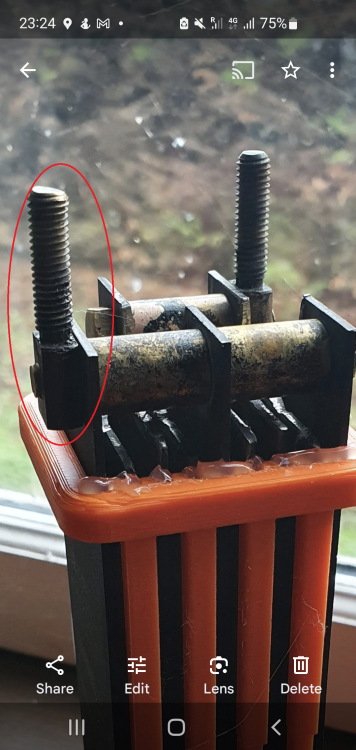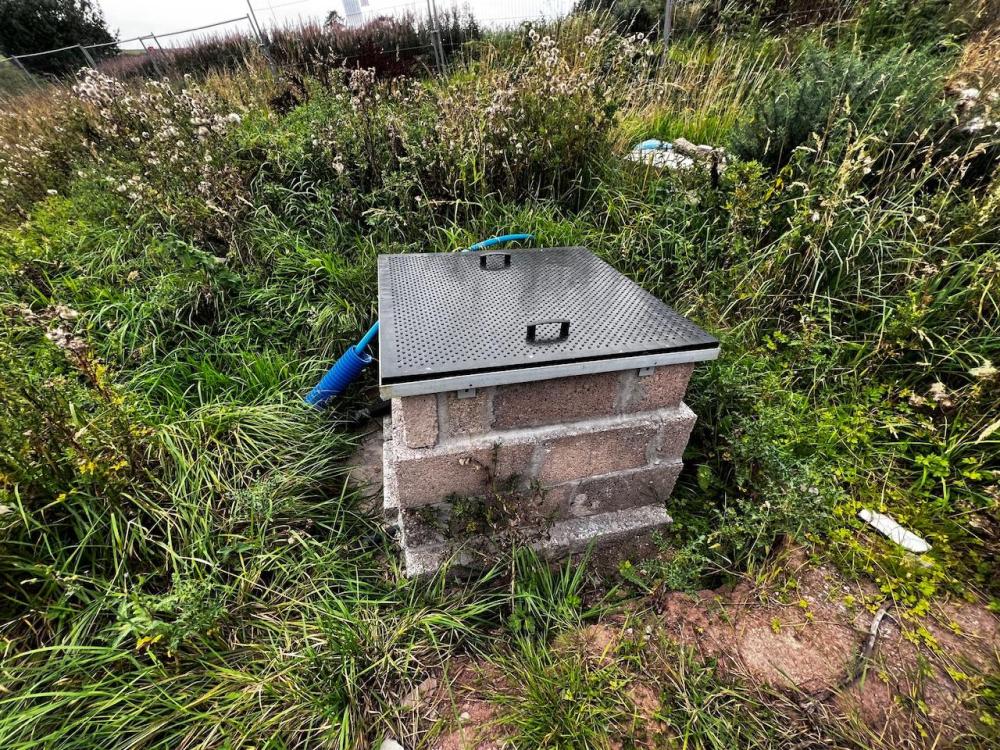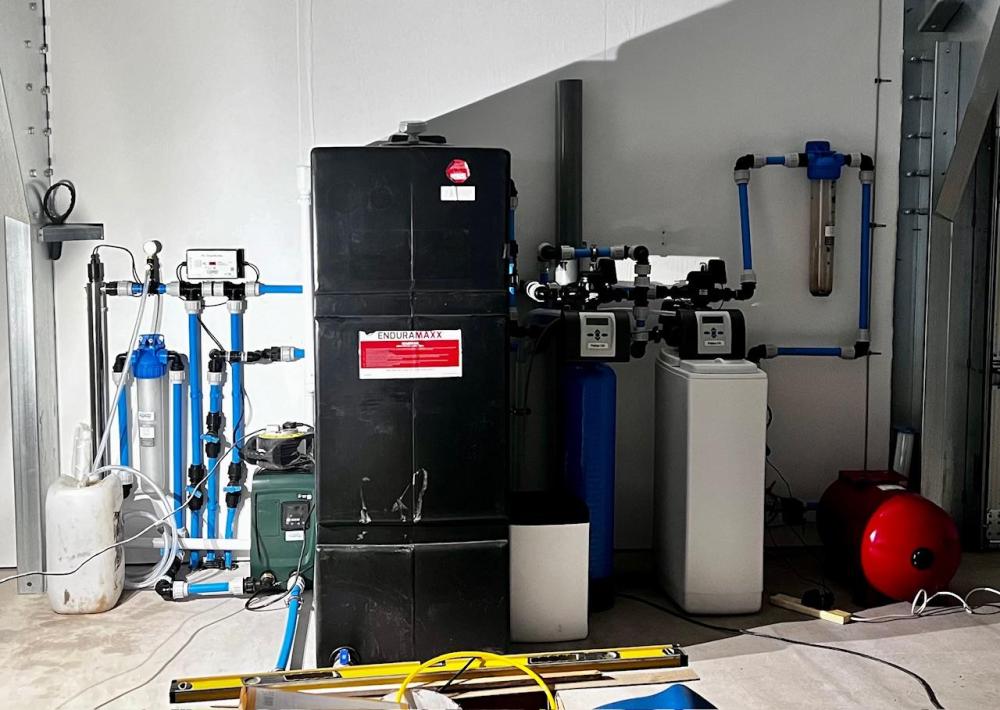Leaderboard
Popular Content
Showing content with the highest reputation on 04/22/24 in all areas
-
We had our first air tightness test today and achieved 0.25 ACH!! 🎉 Absolutely chuffed to bits with that. We have spent a lot of time taping every possible penetration, but I was still anxious in case we hadn’t quite been as scrupulous as needed.14 points
-
Hi, I’ve been a member for a while but have been mostly sitting, getting frustrated, waiting for our planning decision. 2 weeks ago we finally got our approval for a strawbale house in the village of Minard, in Argyll and Bute. Now we’re moving into the building warrant stage and at least this time, we’re prepared for a wait - our planning took ten months after being told ten weeks. I’m a bricklayer by trade and this one is going to be the last house I build. 61 years old and I’ve had enough, but definitely looking forward to getting stuck into this. Graham Walker3 points
-
2 points
-
We used Tescon tape. The wide one was handy for window reveals, and the split one was good for the fiddly bits.2 points
-
If you could see PM10s, let alone PM1s, you could get a job in a chemical laboratory, would save getting the microscopes out. As I said, you are only convincing yourself.2 points
-
To save me high jacking someone's quite sensible topic, I thought I would have a quick look at straw as a building material. It is often touted as a sustainable, low energy input material, so I thought I would look up how much straw is harvested from a hectare (10,000 m2) of land, a nice size garden, but only 1/13,293,000 of the land area of England. Taking wheat straw, it is an average if 4 tonnes/hectare, the wheat itself was 7.8 tonnes (both 2021 figures and from here). There are some standards for straw bails and the density has to be at least 80 kg/m3 at <20% moisture. Now I think that 'construction' bails have a higher density, but I shall assume 120 kg/m3 for this (weights and measure can be adjusted as better data comes to light). So at 4,000 kg/10,000 m2 and 120 kg /m3, you get 33 m3 out of a hectare. Thermal conductivity has been tested in this paper to be approximately, which goes into different k-values at different densities. They estimated, via testing, that at 120 kg/m3 the k-value was 0. 75 W.m-1,K-1. To get a U-Value of 0.18 W.m-2.K-1 would need 0.41 m thickness (well maybe a little less depending on what it is covered in). That works out at 80 m2 of wall area per hectare. Taking a two storey house 10 m by 7 m by 5 m high, with 25% window and door openings, that works out at 127 m2 external wall area. Or, 1.6 hectares of land (16,000 m2). Just to put that into perspective, on the same area of land you could put a solar farm of approximately 1.5 MW installed capacity. That would yield about 1.5 GWh of electricity each year. That is enough power for about 100 houses. Ok, so you do loose the usefulness of selling some wheat, about £1600/year and the ability to 'grow' enough straw to insulate one house a year. But even 3p/kWh you get £45,000 a year for selling the power. So is building from straw really a good idea? (it is late and I may have made a mistake on my arithmetic, but I am sure others will spot it and put me in my place)1 point
-
I’ve noticed the skepticism wow! I’ve done the research and spent a lifetime in the construction industry, as has my dad, who is also involved, albeit not in a physical capacity. I’m hoping for 6 months on the warrant. Thanks for the welcome 🙏1 point
-
Welcome Graham. I hope you'll share your build here as it goes. There's a lot of skepticism about straw bales on this forum; me I'd build a straw house if I could for the carbon footprint, but mostly as I like the aesthetic they end up with. Fingers crossed that the warrant doesn't take as long as planning did.1 point
-
Yes, but cob has worked for hundreds of years in the UK. It has also failed spectacularly where modern materials (sand/cement renders) have been used to repair it. Yes, it is 'newer', but there is at least one straw house in USA over 100 years old and many an awful lot older than 20 years. Straw bale in the UK is pretty young, so yes, 20 years may be 'the norm' in UK, but arguably (and I haven't checked the true figures) because the 'start' was only 20 years ago. It doesn't mean they won't last another xxx years+. You are right that lime and a big roof oversail will help a lot.1 point
-
>>> But i dont have any real means to compare the output of the 2. Suggest light will be ~proportional to area, so 14" will let in roughly twice the light of the 10". Our eyes are a bit logarithmic though, so perceived extra brightness might well be < twice. Does that help any?1 point
-
I'd go for the smaller one central. You will still get plenty of light but may regret it if it's not central. I had a battle to get mine in the centre but glad I did. Phone just died on me so photos later.1 point
-
Perhaps it’s worth revisiting that vague recollection? They work well. If you’re considering MVHR then you must be planning on good levels of air tightness and if you are, why punch a big old hole in the wall to let all that lovely warm air out?1 point
-
I fitted 2 14 inch Velux in to mine and none in the identical house next door. The difference is like night and day ! I am on site I'll post some photos soon. I don't regret it for a minute.1 point
-
The meter you get here is determined by the tariff you choose. Fyi, we're on economy 7 and save about £300 a year compared to standard tariff. You need to shift a good 50% of usage on to the night time to make it worth it.1 point
-
You'll be surprised how even the smallest drip will cause pressure loss in a sealed system. Given it's a new system, this could be in any multitude of places which you can very carefully inspect. The other option is to pour some CT1 miracle seal into the empty radiator before you re-pressurise next time. Then see if it solves the problem.1 point
-
Not sure about grants. Short read https://www.mdpi.com/2073-4433/11/12/1326 Another opinion https://www.scan-stoves.com/this-is-scan/sustainable-heat/sustainable-wood-burning-heat-clean-burn-fireplace#:~:text=Enova (responsible for the net,as warmth for your house. My Experience Have a HETAS Scanline (nominal output is 4.7kW) is stated as particle emissions of 0.63 grams per kilogram of burnt wood. And emission levels of PM dust (at 13% oxygen) of < 3 mg / m³. Overall emissions are below Not quite resolved but reduced particulate matter. Interesting is the allowable limits and what my stove actually achieves. Another source of information says this (below), which again can be misleading. For example it says Defra Exempt Ecodesign stove is up to 335g/MWh for particulate matter. However using my example above, it is less it 13x less than the allowable PM emissions (less than 3 compared to an allowed equal to less than 40). I do know that one or a max of 2 decent logs is all I need to heat the house and the burn time is several hours, once extinguished the soapstone carries on giving off low levels of heat for many hours. However we have have the fire on infrequently, we only use logs that are old and very dry. Most of the wood is from trees that were ready to fall down (dead or starting to rot in the centres) and taken down for safety reasons. Other site generated wood is, timber off cuts from the build, and trees removed because they were in the way.1 point
-
We haven’t installed the kitchen as yet, but our cooker hood will be a circulating one.1 point
-
You are on expensive rates. Mine E7, is 13.67p night, 30.88 day and 60p standing charge. All metered via a standard (Octopus) smart meter, which comes pre configured for E7 tariff times - our smart meter is actually dumb, due to zero communication with the outside world due to our location. You will have zero choice, you will get a stock smart meter. If it communicates with the outside world, they just change the settings to suit your tariff. If it doesn't it's either standard tariff or E7 - nothing else. Been there got a tee shirt.1 point
-
Just say economy 7 import / export meter. I think they are the same anyway.1 point
-
And then there is the actual science and the facts. Particulate matter is very bad for you. All that nasty pollution comes from wood burners. You may not like the facts but that does not make them any less true.1 point
-
1 point
-
Brilliant result. Well done. Do you mind me asking, have you used a recirculating cooker hood or is it vented?1 point
-
1 point
-
1 point
-
Some would say yes 🙂 However, it's your build, and if you want it a particular way make it happen. Be ready for change control payments 😉1 point
-
Top result. Please tell me what construction is your build? Timber, ICF, block cavity?1 point
-
1 point
-
1 point
-
Great effort, well done. Our first test was 0.88 and we got it down to 0.43. Haven’t done the final test yet.1 point
-
1 point
-
1 point
-
Local planning restriction "windows should have a vertical form" Most of our windows were 2 panes side by side, but this one smaller window we thought it a good idea to split it with the centre bar to make it in keeping with the others. No technical reason whatsoever.1 point
-
I have no experience but I think a couple of people on here have tried them. I don't see why it would be any different to increasing the radiator size, or the flow temperature. The absolute humidity (the grams H2O/kgair) would stay the same, so the relative Humidity would just follow the normal Temperature/RH curve.1 point
-
Does that mean you do not believe the science behind the debate? Isn't that like saying it is OK to steal from a shop because you heard that someone else had done it.1 point
-
You shouldn’t need a log burner in a house built with high levels of insulation and air tightness. There are folk on here with very little on the way of heating at all. Opportunity missed there. But this attitude is why, ultimately, humanity is screwed. At an individual level the odd person burning stuff isn’t so bad. Scaled up to millions then it starts to matter. It’s why the oceans are full of plastic, the countryside full of rubbish. I’m being hypocritical of course as we built a house and the cost to the environment isn’t zero. Buying an existing house might have been more sustainable. Over its lifetime our house should net out but that depends of a number of things. You can scale this up to countries too. Why bother doing anything in the UK as we are too small to make a difference. Etc.1 point
-
Hi All, thanks for having me. We’re currently weighing up the question of whether to move house to gain more space downstairs and an extra bedroom, or whether a single storey rear extension and full loft conversion will be cheaper. I have some specific questions around permitted development that I hope you all can assist me with. I’ll post the specific under the relevant area shortly1 point
-
That’s because the whb can impede on the space as long as its wall hung without floor support or a pedestal - hence not impeding access.1 point
-
Personal preference, but if the hob is on the island then it could get very cluttered there and look very cluttered as well. The idea fleetingly crossed our minds in the planning stages because it seemed to be the new ‘in thing’. On closer contemplation it would have been a big mistake so I’m glad we went all conventional and had the hob on the island and the sink on the wall behind it.1 point
-
Old house sink on the island. New house, sink on the wall and hob on the island. Far better for many reasons. Less mess, more sociable when cooking, looks neater etc.1 point
-
I thought I’d do a longer write up about my water supply as it wasn’t that straightforward to get where we are now, a plentiful supply of potable water, and I’ve learnt a few things along the way. As we all know, no water no house so it’s an important part of the self-builders due diligence when buying the plot. While there is mains water nearby our plot it’s insufficient for the existing few houses. The few houses get their water via various sources, mains, boreholes, a well, and out of the burn. I made it a condition of the sale of the plot that the farmer had to find a water supply on the land which, in our case, was going to be via a borehole. There are lots of people out there that can drill holes in the ground but the lesson here was definitely if you buy cheap you buy twice as the first guy the farmer used failed to find water and made a right mess of the neighbouring house. I recommended he use the same company that drilled the other boreholes in the area which he did and they eventually found water at 147m. Most boreholes are mapped by the British Geological Survey and generally a scan of the drilling report is attached to the map location. This isn’t going to tell you if you’ll find water on your plot of course but it is useful to know. https://mapapps2.bgs.ac.uk/geoindex/home.html?layer=BGSBoreholes&_ga=2.140231729.386343147.1696503272-1218241145.1696503272 When a borehole is drilled you need to make sure you also get the drilling report and the water analysis. This will confirm if the supply is viable as it will tell you the yield and what treatment may be necessary, if any. This is important to know as the difference in cost can be many thousands of pounds and might dictate how and where you put all the necessary equipment. For example, if the yield is significant and no treatment is required then you need minimal equipment therefore less space and cost. Typically the drilling company will pump the borehole for a while. In our case this was two weeks. It’s worth noting that drilling a hole in the ground is a messy process. There’s a lot of material comes out of the hole. If they don’t damp the drill with water this sandy material will go everywhere. In our case it covered the neighbour’s house in red sandstone dust. Not a great start with our only neighbour. Our drilling report showed there was enough water for 60 people assuming a daily water use per person of 150 litres/day. Our borehole yield is 380 litres per hour. It sounds a lot but it isn’t in reality and one company I spoke with described it as technically dry. They look for at least 500 litres/hr as a minimum. The water analysis showed that it was moderately hard and borderline for a water softener. It also showed very slightly elevated nitrite levels in the water. Nitrites can be treated in the same way as nitrates and removed via reverse osmosis or ion exchange. Two companies I spoke with reckoned the nitrite levels would probably reduce over time such that no treatment would be necessary. After a bit of research I decided to install both the water softener and the nitrite treatment filter anyway. However, I wanted to have non-softened drinking water in the house as well as the softened water. This complicates the plumbing of it all slightly which I’ll talk through later. The borehole comes up to a wellhead and into a headworks chamber. For very simple installs, that requires no treatment or intermediary storage tanks, the chamber could be a large kiosk that houses all of the equipment for your water supply to your house. These kiosks are quite large and stand 1.2m tall typically. That’s not an issue if you are able to site it all at your boundary or at the bottom of the garden hidden out of view. If your install isn’t as straightforward then you might need a separate shed or space to house all the equipment in. In this case the headworks chamber just makes safe the borehole and associated control electronics for the borehole pump. It might also include a heating element. I found it quite hard to get specific information on how to build the headworks chamber. All of the companies I spoke with said this is to be supplied by others. The only thing they stipulated was it had to have at least 300mm of space above the borehole and ideally 400mm of space around it. They can be above ground or below ground but if below ground you need to make sure that excessive ground water can’t contaminate your water supply. A friend has a poorly installed borehole chamber that floods when there’s heavy rain and contaminates his water with groundwater. SEPA handily provide a guide on best practice for building your headworks chamber which I mostly followed. http://www.groundwateruk.org/downloads/SEPA_borehole_construction.pdf I also considered using concrete well rings with a secure cover but this became expensive and logistically hard to achieve given the weight of them but worth considering if you have the space and means to do it. I spent an inordinate amount of time deciding on the chamber dimensions. It needed to be big enough for ease of access without being too big that it dominated that part of the garden. To some extent this was determined by the manhole cover dimensions. I decided on 750mm x 750mm and ordered a Clark Drains cover from the drainage superstore. I built the headworks chamber out of concrete blocks as I already had the materials on-site with a dimension of 800mm x 800mm. This turned out to be a poor decision for a few reasons. It seems 750mm square manhole covers aren’t that common so the choice was limited. They are also really heavy so aren’t very accessible if they aren’t at ground level which mine isn’t. The Clark Drains cover I bought was poorly made as the frame is very flimsy and the lid quite heavy which only fitted if I hammered it into place. Concreting the frame in place didn’t work as the concrete fell apart as soon as I tried to remove the lid. Ideally I really wanted a plastic lid for ease of access but they don’t seem to exist other than specialist lids that cost a fortune. I then happened across this company: https://www.forecourtsolutionsltd.com They make bespoke plastic covers among other things. I sketched out what I wanted and they turned that into a workable metal frame and plastic cover. I’m really happy with the final chamber. The lid is watertight and easy to access. I have included a drain at the bottom protected with rodent mesh at either end. The electrics and MDPE water pipe enter through a sealed hole. I’ll backfill around it to reduce the height of it a bit and eventually plant around it to hide it. I’ve included the electrics for a heater but haven’t installed a heater yet. I’ll insulate it for this winter and see how it goes. The borehole is 147m deep with the pump at 80m. It has water level sensors at 10m then every 20m. It’s designed to pump the water from 50m to 80m then stop to let the borehole recharge. This is controlled by a control unit in the garage. Our borehole recharges quite slowly, too slowly to use the water directly without an intermediary tank. The picture below shows the layout. From right to left we have a 30 litre pressure vessel which takes the incoming borehole water. This goes through a 50 micron filter, then into the water softener. From here it goes through the nitrite reduction treatment then into the 1000 litre storage tank. It comes out of this tank into the Dab Esybox mini 3 (which is very quiet) then into the 5 micron filter and finally through the UV disinfectant system. From here it then goes out to the house. In addition there's an outlet to an outside stand pipe. We also have ‘raw’ water outlet to the house for a single drinking water tap. It goes through the 50 micron filter and the nitrite treatment then into the house. I’ll have to add another 5 micron filter and another small UV disinfectant system in the plant room in the house. It’s also not pumped so will just rely on the pressure vessel to get it to the house. The total cost for the plant equipment, installation, and commissioning including a type B water analysis and 4 bags of salt was £9909 ex VAT. The borehole cost was separate and very expensive (£18,000) but I didn’t pay for that. I looked at a number of companies to supply and install the equipment as follows: Highwater - they drilled my borehole and did a neighbour’s install. I found them difficult to get a quote from and when I did it was extortionate at £18,000 not including the nitrite treatment and estimated £24,000 including it. They are known to be expensive. Rayburn - couldn’t get them to return my calls GRC - spoke to them a couple of times but didn’t get a quote from them The Water Man - really helpful, estimate was around £8000 but he’s a one man band and extremely busy so decided not to use him. He has a good reputation though. Filpumps - The company that I went with. I attended a webinar on private water supplies hosted by The Scottish Self Build team which Filpumps presented. I’ve found them great to deal with throughout. Very flexible and quick to respond. The installation guys were great, neat, tidy, and helpful. A long post but hopefully of some use to anyone that might need to install private water supply.1 point
-
I find the biggest barrier to solar hot water, however you organise it, is when you want to use the hot water. I am a "shower in the evening" person. All I need in the morning is tepid water to wash my face. So for me starting the day with a completely cold tank and only heating the HW somehow when the sun is up, and then using that hot water in the evening would be fine. That plan goes out of the window when someone else wants a morning shower on any day of the week she feels like. So the only compromise for that is leave the ASHP on to heat the tank when it needs until bed time and there is always enough HW in the tank for that morning shower. I have not succeeded in changing that behaviour, but feel if you could, better use would be made of solar PV for heating more of the water.1 point
-
0 points
-
We had one in our last house for an otherwise dark landing. It worked very well indeed. But if I had a £ for every time a visitor said they could not find the switch to turn the landing light off.0 points
-
Thanks for the prompt. Actually I do recall now that indeed they work plainly awful.0 points
-
I prefer my sinks to be window facing so I can gaze regretfully at all the years going by....0 points
This leaderboard is set to London/GMT+01:00














